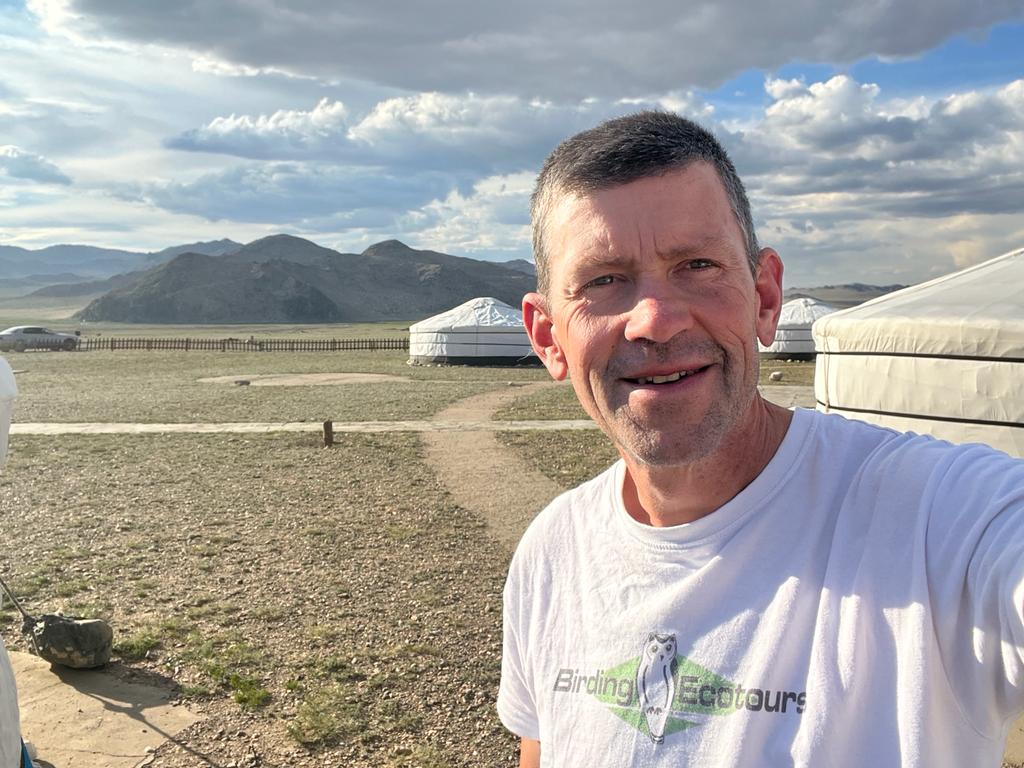
Chris is the owner and CEO of Birding Ecotours, and loves being a professional birder!
You have been leading and organizing birding tours for more than 20 years now. Can you tell us a bit about trends in the past few years, for example, with regard to the preferred locations or the length of tours?
Yes, it has been very interesting to be in the birding tour industry for over two decades and to see some things changing a lot, and others not changing at all. One of the most obvious changes that I have witnessed is which destinations are popular and which aren’t. Sometimes there are obvious reasons for this.
- For example, Colombia used to be a no-go country, but when it became safe for birders to visit, naturally (as the most bird-rich country on the planet), it became immensely popular, and we now offer many Colombia tours.
- A great many people used to visit Peru (which only slightly trails behind Colombia in terms of its total bird list), and its popularity has declined since Birding Ecotours first started, probably because of competition with Colombia.
- The western/Indonesian half of New Guinea (West Papua) used to be one of our top sellers as it was less pricey than PNG, but since costs have burgeoned, many people are simply booking our PNG trips instead, and we don’t always run our West Papua tours annually anymore like we used to.
- Malaysian Borneo (Sabah) has also become pricey.
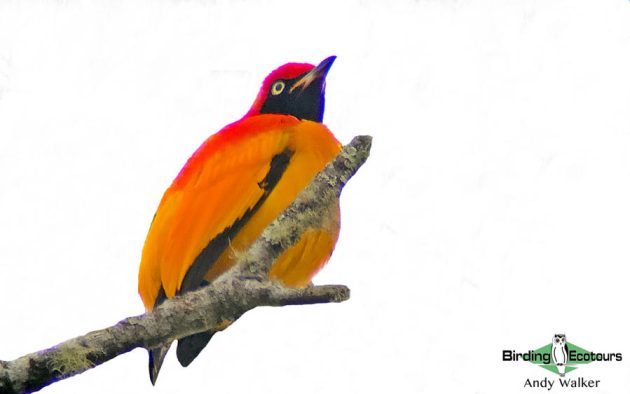
Masked Bowerbird from the West Papua birding tour, previously a particularly popular tour
There are destinations that have stood the test of time, though. Good examples of these are Namibia, South Africa, and Australia, which are, simply, ever popular.
There have been two major world events that have had huge impacts. The Great Recession of 2008 meant that hardly anyone booked birding tours for 6-9 months, but thankfully, things normalized quite soon. The COVID pandemic meant we could only operate one single tour (to Kenya) for a full year starting in March 2020. In 2021, only our American trips sailed, but we had stacks of them as Americans were itching to travel but couldn’t go abroad yet. Our US birding trips were oversubscribed, and we added additional departures. It was only in 2022 that our worldwide trips started running, but it was our busiest year ever, and we wondered whether that was just an artifact, but 2023 was busier than 2022, 2024 was even busier, and 2025 has been our busiest year ever (so far). So, a major trend seems to be that there are more people wanting to do birding tours (at least with our company), since COVID-19 ended.
Regarding the lengths of tours, we have always (consistently) had a good number of clients who like to do back-to-back trips and spend a month or even more in a region, especially if it is a long flight to get there. For example, people often book our Australian or southern African trips back-to-back. But, since not all our clients are retired, there has always been a demand for 7-9 day trips, such as our Costa Rica winter escapes or our Cape Town area trips that are marginally over a week long.
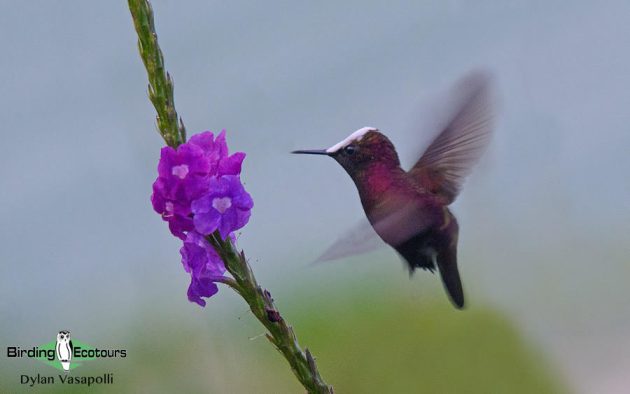
Snowcap in Costa Rica
In a similar vein, seeing the increased interest in bird photography, are your tours also becoming more geared toward photographers?
That’s a good question. Only a small proportion of our tours are birding photo tours, and the vast majority of them are traditional birding tours. But, with advances in cameras, we’re finding that more and more clients are bringing their cameras along on our conventional birding tours and getting decent photos of many species, without slowing down the pace or frustrating participants who don’t have cameras. Many participants certainly enjoy posting photos of the spectacular birds they’ve seen on our tours on social media, also something that didn’t exist when we first started as a company. Our team is currently talking about adding some additional photography-oriented tours, though.
Who are the typical participants of your tours, for example, in terms of age, profession, or gender? Are more women taking your tours these days than in the earlier days?
We’ve always had many women birders joining our tours, and I wouldn’t say there are more now than there used to be. Many American and Canadian couples join our tours, and in many instances, the female partner is the most enthusiastic birder, with the male partner quite often just joining for the travel experience. In terms of age, two-thirds of our clients have always been retirement age.
I do, however, think that more younger/still working birders are joining our tours these days than in the past. I think it is a slow but steady trend happening, with younger people joining our birding tours.
Our clients represent a great diversity of professions, and it is tough to think of one or two professions that are better represented than others, apart from those saying “I work at happily retired!”. Interestingly, we do sometimes have birding guides joining our tours as clients, e.g., on our 2025 Angola trip.
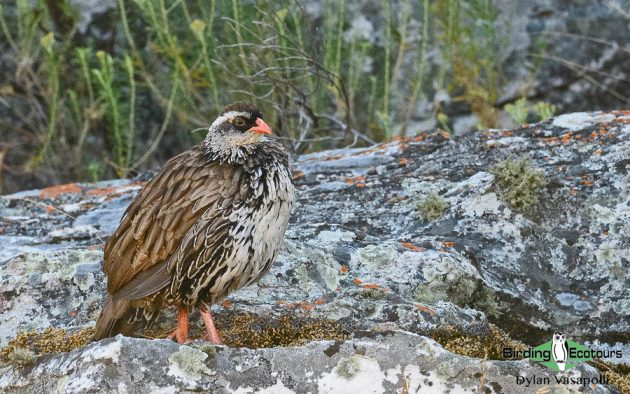
Rare Swierstra’s Spurfowl in Angola
What do you and your guides think of the rise of apps to detect species by sound or image – does it make leading tours easier, or does it take away some of the knowledge advantage of the tour leaders?
The rise of birding apps makes life easier, in my mind. Earlier this year, when I was trying to find Firecrest for someone, Merlin picked up the call of one among a cacophony of other species’ calls, and it was useful to know one was there, and it helped us lay eyes on it quickly, while it was at eye level. Tools like this can only help; it is like having an extra set of ears. Sometimes the apps aren’t correct, for example, they often detect Eurasian Treecreeper erroneously as Short-toed Treecreeper here in the UK, and that is where the guide’s knowledge of course overrides the app/birding AI.
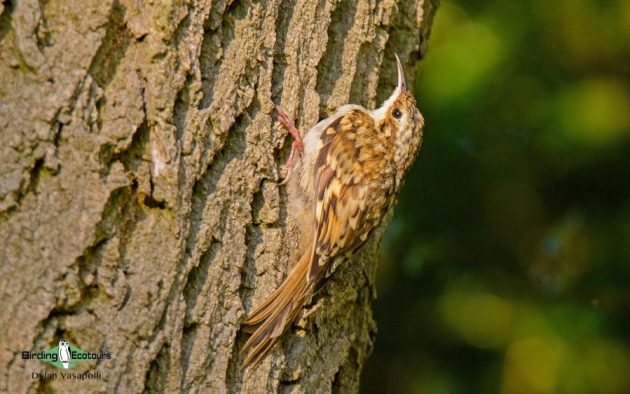
Eurasian Treecreeper
On a more general note about technology, when Birding Ecotours was a new company, navigating to birding sites was far more challenging than it is now. We had to use conventional paper maps. Now we have access to Google Maps, eBird directions to hotspots, information about each species, etc., the lives of birding guides are easier (in my opinion). We can also now do eBird lists in the field, and then revise our day’s list each evening with the printed list/tour booklet.
How often do you change the destinations of your tours? By now, is there more or less a fixed set of destinations, or are destinations dropped and added frequently?
We tend to get very excited about adding new destinations to our existing repertoire. So, yes, we do keep adding them. The world is such a big place, and there are always new destinations to add. We are currently busy adding some places we really should have been doing for years already, but have not really had time. Some examples of these are Mexico, comprehensive Zambia, new parts of Brazil and Australia (such humongous countries), new islands within the Philippines and Indonesia, and so forth. We also have places ready to go as soon as safety and other issues allow – e.g., Socotra and Cameroon.
We do “pause” or discontinue tours or destinations occasionally if they become unsafe. Sometimes it is also about staffing. We have just employed a full-time person in Colombia, Giancarlo, so we are adding more tours there; in the past, most of our Colombia tours were about 2.5 weeks long, but we have recently added short trips for folks who have less time, e.g., are still working. In South Africa, we have recently added two “budget” tours just to offer people a way of doing some great birding there without paying as much as usual.
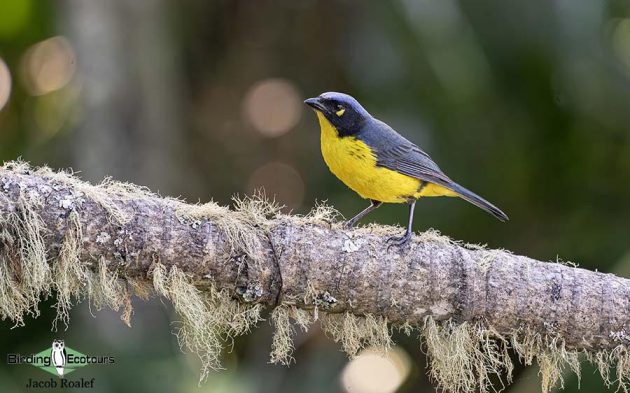
Santa Marta Mountain Tanager, an endemic to Colombia’s Santa Marta Mountains
How differentiated are the bigger birding companies – do they pretty much all offer the same tours, or are there major differences?
The international birding tour companies do differ. While this may not apply to all of our tours, the general/usual philosophy of Birding Ecotours is to
1) Strive for the highest bird lists (and analysis of trip reports shows that this goal is often achieved – yay), but to
2) Add a day or two to the itinerary, as we also want tour participants to have fun, rather than to get completely tired out.
On most of our tours, we also stop for each new mammal, so in some African countries, we can end up with over 50 mammal species and amazingly high bird lists. Other companies may ignore mammals and instead focus 100 % on bird listing. So, some companies will focus only on bird listing, but others (like us) will consider bird listing very important, but will additionally consider getting good views of the birds, and stopping for mammals (and some other things) very important as well.
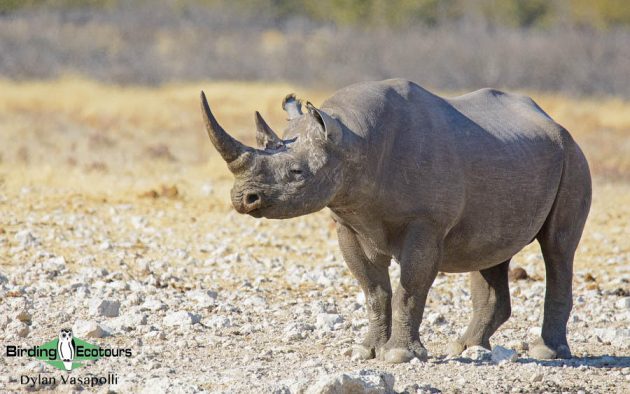
Namibia is probably the easiest country to see the Black Rhino
When possible, we err on the side of using higher quality accommodation and vehicles, even if it costs more, and sometimes, but not always, this means our tours are a bit more expensive. Naturally, other companies try to make their trips as cheap as possible, and that is their priority. So, if you want to bird on a budget, it may be worth choosing one of those companies even though you “rough it” more during the tour.
Some, but not all, companies have a conservation ethic. For example, it is part of Birding Ecotours’ business plan to donate a minimum of 10 % of its annual profits before the owner’s salary to conservation.
What advantages do birders have in taking birding tours with your company rather than hiring a local guide on their own?
This is a great question. There are several possible advantages, e.g.:
- Sometimes a group trip (with say 4-8 participants) with an international tour company can be less expensive than a private trip with a local guide (as there is no one else to share vehicle, guide, and other costs with). Naturally, this is not always the case, as bigger tour companies have lots of overheads (many office/support staff and other large costs).
- Sometimes our tour leaders are, in fact, local guides. For example, our Peru tours are guided by one of our original full-time team members, the awesome Eduardo Ormaeche, one of our most popular guides. He is based in Peru and knows his country thoroughly. The same applies to our fantastic South African staff members. They know southern African birds better than any foreign visiting leader would ever be able to know because they have been birding the region since childhood. Since we have numerous staff members in South Africa, they function as local guides there. This not only allows us to get some of the best bird (and mammal) lists (because of the local knowledge), but the prices are competitive as we only have 1 guide/leader, not 2, even though the maximum group size of our South African tours is only 6 paying participants, and even though we tend to use superior accommodation compared to other companies. We also have guides based in Colombia, Indonesia, etc.
- Some local guides are excellent, but some are terrible, and then there is everything in between. So great care needs to be taken to choose someone who is going to find the birds, provide a quality experience, and above all, provide a safe experience. Seasoned and adventurous travelers may be less concerned about these things, but if you want the safety and consistently high standard that an international tour company can offer, then this can be a major advantage
- Some companies (including Birding Ecotours) will arrange a trip with a local guide they trust, if you ask them to do so. The biggest advantage, apart from the cost savings, is that they have the expertise and network to know which local guides to use. In many cases, these may be the ground operators they have relied on. We have, for example, sent people to Madagascar, Indonesia, India, etc., with our local guides, and we have also provided backup support in case something goes wrong. If there is a destination in which we feel the experience won’t be safe or of high quality with a local guide, we, of course, will be honest about that and say so. But in many countries, we know of awesome local guides, and we can set things up if asked.
- Using an international birding tour company does come with the support of office staff just in case something goes wrong, which local guides don’t always have (but there are some very good local birding tour companies, and not all international companies have proper office support, so all that needs to be taken into account).
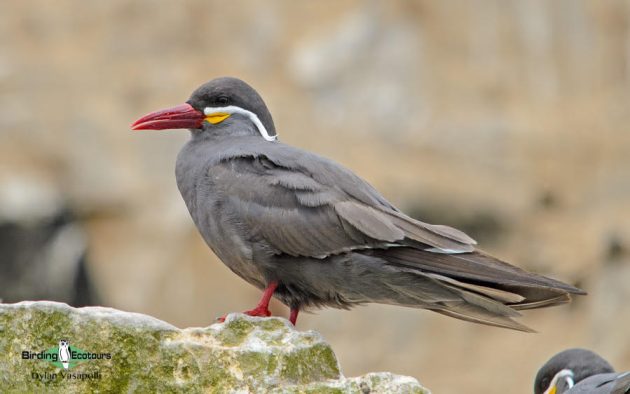
Inca Tern seen along the Peruvian coast
What are your biggest challenges in running the company and the tours?
- Finding the best staff members who are 1) excellent with people (put 1st as it is even more important than the 2nd item) and 2) brilliant birders, is not easy. So, staffing is always a big challenge, which means we really try to look after team members once we have found them. This is why, for example, we paid our guides in full through the Covid pandemic – a major challenge in itself, of course.
- Finding communicative, competent, legal (all their paperwork in order), etc., ground operators/local guides to partner with is another major challenge. Over the years – and decades – we have built up a network of amazing people and local companies we can rely on
- Finding clients is always difficult, but the good news is that we have stacks of repeat clients who prefer our way of doing things.
How do you see the link between birding tours and conservation? Presumably, birders and birding tours do create a certain amount of disturbance for birds – how do you judge these compared to the benefits?
This is a good question that is close to my heart, so in fact, I wrote an article about exactly that: “The conservation value of avitourism – Birding Ecotours.” The summary of what I wrote there was that the conservation value of avitourism far outweighs the costs, because thousands of people are now birding guides instead of loggers and hunters, so they are protecting the bird habitats (their livelihoods) rather than destroying the habitats. In some countries, such as Costa Rica and Botswana, this has transformed everything, and these are countries that are conserving their fauna and flora quite well (because of ecotourism).
It has to be done the right way, though. As one example, now that Botha’s Lark has been uplisted from Endangered to Critically Endangered (see The conservation crisis facing Botha’s Lark), we avoid showing people this bird. Any disturbance could cause its extinction. It’s on the verge. We put the birds first. Some birding tour companies do disturb birds (even threatened ones), but that is not compulsory; birding tour companies can choose to put the birds first and to keep far enough away, or even avoid some of them, such as Botha’s Lark.
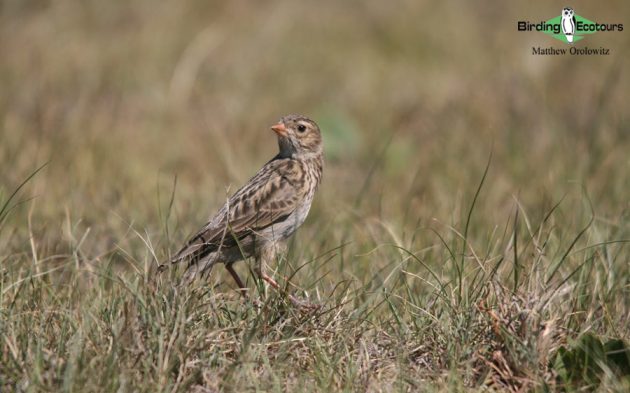
Botha’s Lark
A major potential problem with birding tourism is the carbon cost of travel involved in flying to a destination and then being driven around looking for birds. A few companies, including ours, strive to be carbon neutral, paying into habitat restoration projects that offset the carbon expenditures from this. While this remains a big issue, I strongly believe that far fewer species are going extinct now because of ecotourism for the reasons mentioned above than without it. We are in the midst of a great extinction caused by us humans, and ecotourism is slowing this down.
Frankly, if somebody asked me to be a birding tour guide, I would decline for two reasons. The first, obvious one is that I am not a good enough birder – this is irrelevant for you. The other is that taking a birding tour, even for 2 weeks, leaves me fairly exhausted, and that is without having to do all the additional tasks of a tour guide that do not apply to me as a client. How do you manage? Isn’t it too tiring?
Another great question. Yes, guiding a two (plus) week birding tour can be exhausting. But it involves a different kind of stress compared to office work. What I love about my job is the mix between the two. After three months of office work, a two or three-week guiding stint relieves the normal stresses of being in the office and rejuvenates the mind and body in many ways. My wife Megan sometimes tells me I am getting tired and weary from all my computer work, and that I need a trip, and she’s, of course, always right. But once the trip is over, I am for sure exhausted physically, but in a better mental state to enjoy the office work again, for a while. All of us are different, and my colleague Andy seems to be able to do back-to-back tours forever and never get tired out. But others in the company are more like me and need to punctuate the guiding with stints at home for recuperating.
Is there anything you wish I had asked?
No, you covered this very well, with great questions!






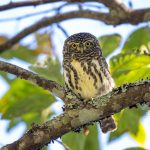
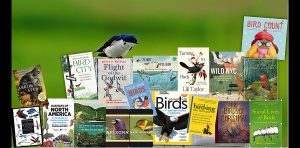

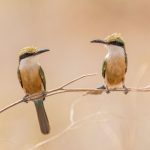
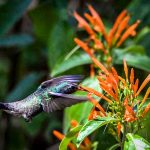
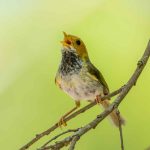
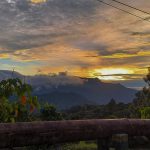
That was a very informative post on things to consider in selecting a birding tour — thank you, Chris, for the thoughtful, nuanced answers.
Quite illuminating article – there has obviously been a lot of thinking going on at Birding Ecotours. I like the conservation ethos.
Very interesting post. The point that the best leaders have to posses good people skills is very important – I’ve encountered guides who were brilliant on birds, but not so impressive at dealing with people. When I was both organising and leading trips I found that many of my clients were people who had (or retired from) high-powered jobs with lots of decision making, but they enjoyed coming on a trip where they could relax and not have to make any decisions.
I agree completely with Chris about the value of bird tours in promoting conservation, and making local people aware of the value of looking after birds and habitats, something that certain UK bird charities ignore or disregard.
Once, when birding in rural Africa, a local man asked me what I was doing, so I explained I was looking for birds. He replied by asking me “Don’t you have birds of your own at home to look at?” We take it for granted that different countries have different birds, but for people with little or no education that’s not obvious. Bird tours can make a real difference to the way that people regard the birds around them.
Thanks so much for your kind comments, Susan, Peter and David! I am grateful to hear your thoughts. Sorry not to have replied sooner but I am nearing the end of a 36 day comprehensive Zambia birding tour!